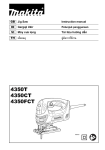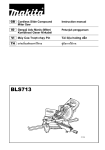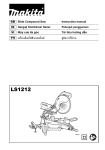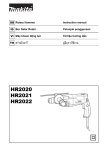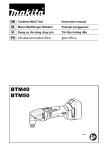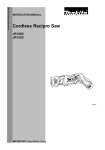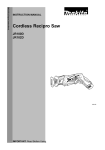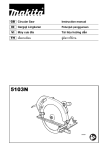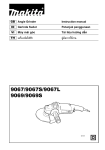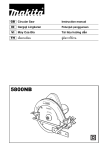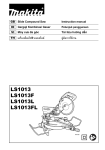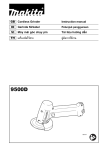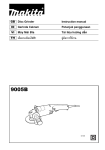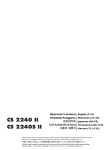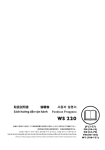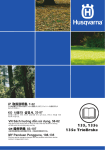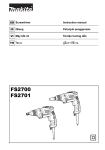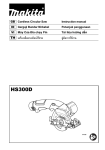Download Makita JR102D Instruction manual
Transcript
GB Cordless Recipro Saw Instruction manual ID Gergaji Bolak-Balik Nirkabel Petunjuk penggunaan VI Maùy cöa kieám chaïy pin Taøi lieäu höôùng daãn TH JR100D JR102D 012163 3 1 2 1 012164 2 012169 8 7 3 012168 012161 13 10 2 9 4 9 5 6 5 4 14 11 12 012162 6 012165 8 15 11 16 7 013062 10 16 15 8 17 012229 9 012230 3 11 18 10 012167 11 012171 12 012172 13 012173 4 ENGLISH (Original instructions) Explanation of general view 1. 2. 3. 4. 5. 6. 7. 8. 9. 10. 11. 12. Buttons Battery Lock-off button Lock-off lever Switch lever Switch trigger 13. 14. 15. 16. 17. 18. Lamp Recipro saw blade Blade clamp sleeve Saw blade Hex wrench Bolt Loosen Tighten Hole for recipro saw blade Blade clamp Hole for jig saw blade Projections SPECIFICATIONS Model JR100D Length of stroke Strokes per minute (min-1) Max. cutting capacities JR102D 13 mm 0 - 3,300 Pipe 50 mm Wood 50 mm Overall length (with battery) 355 mm Net weight 1.2 kg Rated voltage 1.1 kg D.C. 10.8 V • Due to our continuing program of research and development, the specifications herein are subject to change without notice. • Specifications and battery cartridge may differ from country to country. • Weight, with battery cartridge, according to EPTA-Procedure 01/2003 Symbols END004-4 The following show the symbols used for the equipment. Be sure that you understand their meaning before use. ... Read instruction manual. Intended use ENE020-1 The tool is intended for sawing wood, plastic and ferrous materials. General Power Tool Safety Warnings GEA006-2 WARNING Read all safety warnings and all instructions. Failure to follow the warnings and instructions may result in electric shock, fire and/or serious injury. Save all warnings and instructions for future reference. The term “power tool” in the warnings refers to your mains-operated (corded) power tool or battery-operated (cordless) power tool. Work area safety 1. Keep work area clean and well lit. Cluttered or dark areas invite accidents. 2. Do not operate power tools in explosive atmospheres, such as in the presence of flammable liquids, gases or dust. Power tools create sparks which may ignite the dust or fumes. 3. Keep children and bystanders away while operating a power tool. Distractions can cause you to lose control. Electrical safety 4. Power tool plugs must match the outlet. Never modify the plug in any way. Do not use any adapter plugs with earthed (grounded) power tools. Unmodified plugs and matching outlets will reduce risk of electric shock. 5. Avoid body contact with earthed or grounded surfaces such as pipes, radiators, ranges and refrigerators. There is an increased risk of electric shock if your body is earthed or grounded. 6. Do not expose power tools to rain or wet conditions. Water entering a power tool will increase the risk of electric shock. 7. Do not abuse the cord. Never use the cord for carrying, pulling or unplugging the power tool. Keep cord away from heat, oil, sharp edges or moving parts. Damaged or entangled cords increase the risk of electric shock. 8. When operating a power tool outdoors, use an extension cord suitable for outdoor use. Use of a cord suitable for outdoor use reduces the risk of electric shock. 9. If operating a power tool in a damp location is unavoidable, use a ground fault circuit interrupter (GFCI) protected supply. Use of an GFCI reduces the risk of electric shock. Personal safety 10. Stay alert, watch what you are doing and use common sense when operating a power tool. Do not use a power tool while you are tired or under 5 the influence of drugs, alcohol or medication. A moment of inattention while operating power tools may result in serious personal injury. 11. Use personal protective equipment. Always wear eye protection. Protective equipment such as dust mask, non-skid safety shoes, hard hat, or hearing protection used for appropriate conditions will reduce personal injuries. 12. Prevent unintentional starting. Ensure the switch is in the off-position before connecting to power source and/or battery pack, picking up or carrying the tool. Carrying power tools with your finger on the switch or energising power tools that have the switch on invites accidents. 13. Remove any adjusting key or wrench before turning the power tool on. A wrench or a key left attached to a rotating part of the power tool may result in personal injury. 14. Do not overreach. Keep proper footing and balance at all times. This enables better control of the power tool in unexpected situations. 15. Dress properly. Do not wear loose clothing or jewellery. Keep your hair, clothing, and gloves away from moving parts. Loose clothes, jewellery or long hair can be caught in moving parts. 16. If devices are provided for the connection of dust extraction and collection facilities, ensure these are connected and properly used. Use of dust collection can reduce dust-related hazards. Power tool use and care 17. Do not force the power tool. Use the correct power tool for your application. The correct power tool will do the job better and safer at the rate for which it was designed. 18. Do not use the power tool if the switch does not turn it on and off. Any power tool that cannot be controlled with the switch is dangerous and must be repaired. 19. Disconnect the plug from the power source and/or the battery pack from the power tool before making any adjustments, changing accessories, or storing power tools. Such preventive safety measures reduce the risk of starting the power tool accidentally. 20. Store idle power tools out of the reach of children and do not allow persons unfamiliar with the power tool or these instructions to operate the power tool. Power tools are dangerous in the hands of untrained users. 21. Maintain power tools. Check for misalignment or binding of moving parts, breakage of parts and any other condition that may affect the power tool's operation. If damaged, have the power tool repaired before use. Many accidents are caused by poorly maintained power tools. 22. Keep cutting tools sharp and clean. Properly maintained cutting tools with sharp cutting edges are less likely to bind and are easier to control. 23. Use the power tool, accessories and tool bits etc. in accordance with these instructions, taking into 6 account the working conditions and the work to be performed. Use of the power tool for operations different from those intended could result in a hazardous situation. Battery tool use and care 24. Recharge only with the charger specified by the manufacturer. A charger that is suitable for one type of battery pack may create a risk of fire when used with another battery pack. 25. Use power tools only with specifically designated battery packs. Use of any other battery packs may create a risk of injury and fire. 26. When battery pack is not in use, keep it away from other metal objects, like paper clips, coins, keys, nails, screws or other small metal objects, that can make a connection from one terminal to another. Shorting the battery terminals together may cause burns or a fire. 27. Under abusive conditions, liquid may be ejected from the battery; avoid contact. If contact accidentally occurs, flush with water. If liquid contacts eyes, additionally seek medical help. Liquid ejected from the battery may cause irritation or burns. Service 28. Have your power tool serviced by a qualified repair person using only identical replacement parts. This will ensure that the safety of the power tool is maintained. 29. Follow instruction for lubricating and changing accessories. 30. Keep handles dry, clean and free from oil and grease. CORDLESS RECIPRO SAW SAFETY WARNINGS GEB048-2 1. Hold power tool by insulated gripping surfaces, when performing an operation where the cutting accessory may contact hidden wiring. Cutting accessory contacting a “live” wire may make exposed metal parts of the power tool “live” and could give the operator an electric shock. 2. Use clamps or another practical way to secure and support the workpiece to a stable platform. Holding the work by hand or against your body leaves it unstable and may lead to loss of control. 3. Always use safety glasses or goggles. Ordinary eye or sun glasses are NOT safety glasses. 4. Avoid cutting nails. Inspect workpiece for any nails and remove them before operation. 5. Do not cut oversize workpiece. 6. Check for the proper clearance beyond the workpiece before cutting so that the blade will not strike the floor, workbench, etc. 7. Hold the tool firmly. 8. Make sure the blade is not contacting the workpiece before the switch is turned on. 9. Keep hands away from moving parts. 10. Do not leave the tool running. Operate the tool only when hand-held. 11. Always switch off and wait for the blade to come to a complete stop before removing the blade from the workpiece. 12. Do not touch the blade or the workpiece immediately after operation; they may be extremely hot and could burn your skin. 13. Do not operate the tool at no-load unnecessarily. 14. Always use the correct dust mask/respirator for the material and application you are working with. 15. Some material contains chemicals which may be toxic. Take caution to prevent dust inhalation and skin contact. Follow material supplier safety data. SAVE THESE INSTRUCTIONS. WARNING: DO NOT let comfort or familiarity with product (gained from repeated use) replace strict adherence to safety rules for the subject product. MISUSE or failure to follow the safety rules stated in this instruction manual may cause serious personal injury. IMPORTANT SAFETY INSTRUCTIONS Tips for maintaining maximum battery life 1. Charge the battery cartridge before completely discharged. Always stop tool operation and charge the battery cartridge when you notice less tool power. 2. Never recharge a fully charged battery cartridge. Overcharging shortens the battery service life. 3. Charge the battery cartridge with room temperature at 10°C - 40°C (50°F - 104°F). Let a hot battery cartridge cool down before charging it. 4. Charge the battery cartridge once in every six months if you do not use it for a long period of time. FUNCTIONAL DESCRIPTION CAUTION: • Always be sure that the tool is switched off and the battery cartridge is removed before adjusting or checking function on the tool. Installing or removing battery cartridge (Fig. 1) ENC007-7 FOR BATTERY CARTRIDGE 1. Before using battery cartridge, read all instructions and cautionary markings on (1) battery charger, (2) battery, and (3) product using battery. 2. Do not disassemble battery cartridge. 3. If operating time has become excessively shorter, stop operating immediately. It may result in a risk of overheating, possible burns and even an explosion. 4. If electrolyte gets into your eyes, rinse them out with clear water and seek medical attention right away. It may result in loss of your eyesight. 5. Do not short the battery cartridge: (1) Do not touch the terminals with any conductive material. (2) Avoid storing battery cartridge in a container with other metal objects such as nails, coins, etc. (3) Do not expose battery cartridge to water or rain. A battery short can cause a large current flow, overheating, possible burns and even a breakdown. 6. Do not store the tool and battery cartridge in locations where the temperature may reach or exceed 50°C (122°F). 7. Do not incinerate the battery cartridge even if it is severely damaged or is completely worn out. The battery cartridge can explode in a fire. 8. Be careful not to drop or strike battery. 9. Do not use a damaged battery. SAVE THESE INSTRUCTIONS. • Always switch off the tool before installing or removing of the battery cartridge. • To remove the battery cartridge, withdraw it from the tool while pressing the buttons on both sides of the cartridge. • To install the battery cartridge, hold it so that the battery cartridge front shape fits to that of the battery installment opening and slip it into place. Always insert it all the way until it locks in place with a little click. If not, it may accidentally fall out of the tool, causing injury to you or someone around you. • Do not use force when installing the battery cartridge. If the cartridge does not slide in easily, it is not being inserted correctly. Battery protection system The tool is equipped with a battery protection system. This system automatically cuts off power to the motor to extend battery life. The tool will automatically stop during operation if the tool and/or battery are placed under one of the following conditions: • Overloaded: The tool is operated in a manner that causes it to draw an abnormally high current. In this situation, release the trigger switch on the tool and stop the application that caused the tool to become overloaded. Then pull the trigger switch again to restart. • Low battery voltage: The remaining battery capacity is too low and the tool will not operate. If you pull the switch trigger, the motor runs again but stops soon. In this situation, remove and recharge the battery. Switch action (Fig. 2) CAUTION: • Before installing the battery cartridge into the tool, always check to see that the switch lever/trigger 7 actuates properly and returns to the “OFF” position when released. To prevent the switch lever/trigger from accidentally pulled, the lock-off lever/button are provided. To start the tool, pull either switch lever or trigger. • For the switch lever, pull the lock-off lever and then pull the switch lever to start the tool. • For the switch trigger, depress the lock-off button and then pull the switch trigger to start to the tool. The lockoff button can be pressed from either right or left. The tool speed is increased by increasing pressure on the switch lever/trigger. Release the switch lever/trigger to stop. NOTICE: Do not pull the switch lever/trigger hard without pulling the lock-off lever/button. This can cause switch breakage. Lighting up the front lamp (Fig. 3) CAUTION: • Do not look in the light or see the source of light directly. Pull the switch lever/trigger to light up the lamp. The lamp keeps on lighting while the switch lever/trigger is being pulled. ASSEMBLY CAUTION: • Always be sure that the tool is switched off and the battery cartridge is removed before carrying out any work on the tool. Installing or removing the saw blade CAUTION: • Always clean out all chips or foreign matter adhering to the blade, blade clamp and/or slider. Failure to do so may cause insufficient tightening of the blade, resulting in a serious injury. For Model JR102D To install the saw blade, loosen the bolt by hex wrench. When installing a recipro saw blade, press the bolt with the hex wrench to open the slot during inserting the blade. (Fig. 6 & 7) You can use both jig saw blades (B type) and recipro saw blades according to your work. Insert the saw blade straight into the blade clamp and tighten it by hex wrench. Pull the saw blade lightly to make sure that the saw blade does not fall off during operation. To remove the saw blade, follow the installation procedure in reverse. (Fig. 8 & 9) Hex wrench storage (Fig. 10) When not in use, store the hex wrench. It is fixed by two projections as shown in the figure to keep it from being lost. OPERATION (Fig. 11) CAUTION: • Always press the shoe firmly against the workpiece during operation. If the shoe is held away from the workpiece during operation, strong vibration and/or twisting will be produced, causing the blade to snap dangerously. • Always wear gloves to protect your hands from hot flying chips when cutting metal. • Be sure to always wear suitable eye protection which conforms with current national standards. • Always use a suitable coolant (cutting oil) when cutting metal. Failure to do so will cause premature blade wear. Press the shoe firmly against the workpiece. Do not allow the tool to bounce. Bring the saw blade into light contact with the workpiece. First, make a pilot groove using a slower speed. Then use a faster speed to continue cutting. (Fig. 12 & 13) • You can use the switch lever or trigger according to your work. For Model JR100D (Fig. 4) Insert the recipro saw blade into the blade clamp as far as it will go. The blade clamp sleeve rotates and the saw blade is fixed. Make sure that the saw blade cannot be extracted even though you try to pull it out. NOTE: • If the tool is operated continuously until the battery cartridge has discharged, allow the tool to rest for 15 minutes before proceeding with a fresh battery. CAUTION: • If you do not insert the saw blade deep enough, the saw blade may be ejected unexpectedly during operation. This can be extremely dangerous. MAINTENANCE NOTE: • You can not use the jig saw blade with JR100D. (Fig. 5) To remove the saw blade, rotate the blade clamp sleeve in the direction of the arrow fully. The saw blade is removed and the blade clamp sleeve is fixed at the released position. NOTE: • If you remove the saw blade without rotating the blade clamp sleeve fully, the sleeve may not be fixed. In this case, rotate the blade clamp sleeve fully, then make the sleeve fixed at the released position. 8 CAUTION: • Always be sure that the tool is switched off and the battery cartridge is removed before attempting to perform inspection or maintenance. • Never use gasoline, benzine, thinner, alcohol or the like. Discoloration, deformation or cracks may result. To maintain product SAFETY and RELIABILITY, repairs, any other maintenance or adjustment should be performed by Makita Authorized Service Centers, always using Makita replacement parts. OPTIONAL ACCESSORIES CAUTION: • These accessories or attachments are recommended for use with your Makita tool specified in this manual. The use of any other accessories or attachments might present a risk of injury to persons. Only use accessory or attachment for its stated purpose. If you need any assistance for more details regarding these accessories, ask your local Makita Service Center. • Recipro saw blades • Jig saw blades (only for Model JR102D) • Various type of Makita genuine batteries and chargers • Plastic carrying case NOTE: • Some items in the list may be included in the tool package as standard accessories. They may differ from country to country. 9 BAHASA INDONESIA (Petunjuk Asli) Penjelasan tampilan keseluruhan 1. 2. 3. 4. 5. 6. 7. 8. 9. 10. 11. 12. 13. 14. Tombol Baterai Tombol kunci-mati Tuas kunci-mati Tuas sakelar Picu sakelar Lampu 15. Lubang untuk bilah gergaji bolakbalik 16. Klem bilah 17. Lubang untuk bilah gergaji ukir 18. Penonjolan Bilah gergaji bolak-balik Selongsong klem bilah Bilah gergaji Kunci hex (segi enam) Baut Kendurkan Kencangkan SPESIFIKASI Model JR100D Panjang langkah Langkah per menit (men-1) Kemampuan pemotongan maks. JR102D 13 mm 0 - 3.300 Pipa 50 mm Kayu 50 mm Panjang keseluruhan (dengan baterai) Berat bersih Tegangan yang sesuai 355 mm 1,2 kg 1,1 kg D.C. 10,8 V • Karena kesinambungan program penelitian dan pengembangan kami, spesifikasi yang disebutkan di sini dapat berubah tanpa pemberitahuan. • Spesifikasi dan kartrid baterai dapat berbeda dari satu negara ke negara lainnya. • Berat, dengan kartrid baterai, menurut Prosedur EPTA 01/2003 Simbol-simbol END004-4 Berikut ini adalah simbol-simbol yang digunakan pada alat ini. Pastikan Anda mengerti makna masing-masing simbol sebelum menggunakan alat ini. ... Baca petunjuk penggunaan. Maksud penggunaan ENE020-1 Alat ini dimaksudkan untuk menggergaji kayu, plastik, dan bahan mengandung besi. Peringatan Keselamatan Umum Mesin Listrik GEA006-2 PERINGATAN Bacalah semua peringatan keselamatan dan semua petunjuk. Kelalaian mematuhi peringatan dan petunjuk dapat menyebabkan sengatan listrik, kebakaran, dan/atau cedera serius. Simpanlah semua peringatan dan petunjuk untuk acuan di masa mendatang. Istilah “mesin listrik” dalam semua peringatan mengacu pada mesin listrik yang dijalankan dengan sumber listrik jala-jala (berkabel) atau baterai (nirkabel). Keselamatan tempat kerja 1. Jagalah tempat kerja selalu bersih dan berpenerangan cukup. Tempat yang berantakan atau gelap mengundang kecelakaan. 2. Jangan mengoperasikan mesin listrik dalam atmosfer yang mudah meledak, seperti bila ada 10 cairan, gas, atau debu mudah menyala. Mesin listrik menimbulkan percikan api yang dapat menyalakan debu atau uap tersebut. 3. Jauhkan anak-anak dan mereka yang tidak berkepentingan saat mengoperasikan mesin listrik. Bila perhatian terpecah, Anda dapat kehilangan kendali. Keamanan kelistrikan 4. Steker mesin listrik harus cocok dengan stopkontak. Jangan sekali-kali mengubah steker dengan cara apa pun. Jangan menggunakan steker adaptor dengan mesin listrik berarde (dibumikan). Steker yang tidak diubah dan stopkontak yang cocok akan mengurangi risiko sengatan listrik. 5. Hindari sentuhan tubuh dengan permukaan berarde atau yang dibumikan seperti pipa, radiator, kompor, dan kulkas. Risiko sengatan listrik bertambah jika tubuh Anda terbumikan atau terarde. 6. Jangan membiarkan mesin listrik kehujanan atau kebasahan. Air yang masuk ke dalam mesin listrik akan meningkatkan risiko sengatan listrik. 7. Jangan menyalahgunakan kabel. Jangan sekalikali menggunakan kabel untuk membawa, menarik, atau mencabut mesin listrik dari stopkontak. Jauhkan kabel dari panas, minyak, tepian tajam, atau komponen yang bergerak. Kabel yang rusak atau kusut memperbesar risiko sengatan listrik. 8. Bila menggunakan mesin listrik di luar ruangan, gunakan kabel ekstensi yang sesuai untuk penggunaan di luar ruangan. Penggunaan kabel yang sesuai untuk penggunaan luar ruangan mengurangi risiko sengatan listrik. 9. Jika mengoperasikan mesin listrik di lokasi lembap tidak dapat dihindari, gunakan pasokan daya yang dilindungi piranti pemutus arus kegagalan arde (ground fault circuit interrupter GFCI). Penggunaan GFCI mengurangi risiko sengatan listrik. Keselamatan diri 10. Jaga kewaspadaan, perhatikan pekerjaan Anda dan gunakan akal sehat bila menggunakan mesin listrik. Jangan menggunakan mesin listrik saat Anda lelah atau di bawah pengaruh obat bius, alkohol, atau obat. Sekejap saja lalai saat menggunakan mesin listrik dapat menyebabkan cedera diri yang serius. 11. Gunakan alat pelindung diri. Selalu kenakan pelindung mata. Peralatan pelindung seperti masker debu, sepatu pengaman anti-selip, helm pengaman, atau pelindung telinga yang digunakan untuk kondisi yang sesuai akan mengurangi risiko cedera. 12. Cegah penyalaan yang tidak disengaja. Pastikan bahwa sakelar berada dalam posisi mati (off) sebelum menghubungkan mesin ke sumber daya dan/atau baterai, atau mengangkat atau membawa mesin. Membawa mesin listrik dengan jari Anda pada sakelarnya atau mengalirkan listrik pada mesin listrik yang sakelarnya hidup (on) akan mengundang kecelakaan. 13. Lepaskan kunci-kunci penyetel sebelum menghidupkan mesin listrik. Kunci-kunci yang masih terpasang pada bagian mesin listrik yang berputar dapat menyebabkan cedera. 14. Jangan meraih terlalu jauh. Pertahankan pijakan dan keseimbangan yang baik setiap saat. Hal ini memungkinkan kendali yang lebih baik atas mesin listrik dalam situasi yang tidak diharapkan. 15. Kenakan pakaian yang sesuai. Jangan memakai pakaian yang kedodoran atau perhiasan. Jaga jarak antara rambut, pakaian, dan sarung tangan Anda dengan bagian mesin yang bergerak. Pakaian kedodoran, perhiasan, atau rambut panjang dapat tersangkut pada bagian yang bergerak. 16. Jika tersedia fasilitas untuk menghisap dan mengumpulkan debu, pastikan fasilitas tersebut terhubung listrik dan digunakan dengan baik. Penggunaan pembersih debu dapat mengurangi bahaya yang terkait dengan debu. Penggunaan dan pemeliharaan mesin listrik 17. Jangan memaksa mesin listrik. Gunakan mesin listrik yang tepat untuk keperluan Anda. Mesin listrik yang tepat akan menuntaskan pekerjaan dengan lebih baik dan lebih aman pada kecepatan sesuai rancangannya. 18. Jangan gunakan mesin listrik jika sakelar tidak dapat menghidupkan atau mematikannya. Mesin listrik yang tidak dapat dikendalikan dengan sakelarnya adalah berbahaya dan harus diperbaiki. 19. Cabut steker dari sumber listrik dan/atau baterai dari mesin listrik sebelum melakukan penyetelan, penggantian aksesori, atau menyimpan mesin listrik. Langkah keselamatan preventif tersebut mengurangi risiko hidupnya mesin secara tak sengaja. 20. Simpan mesin listrik jauh dari jangkauan anakanak dan jangan biarkan orang yang tidak paham akan mesin listrik tersebut atau petunjuk ini menggunakan mesin listrik. Mesin listrik sangat berbahaya di tangan pengguna yang tak terlatih. 21. Rawatlah mesin listrik. Periksa apakah ada bagian bergerak yang tidak lurus atau macet, bagian yang pecah dan kondisi lain yang dapat mempengaruhi penggunaan mesin listrik. Jika rusak, perbaiki dahulu mesin listrik sebelum digunakan. Banyak kecelakaan disebabkan oleh kurangnya pemeliharaan mesin listrik. 22. Jaga agar mesin pemotong tetap tajam dan bersih. Mesin pemotong yang terawat baik dengan mata pemotong yang tajam tidak akan mudah macet dan lebih mudah dikendalikan. 23. Gunakan mesin listrik, aksesori, dan mata mesin, dll. sesuai dengan petunjuk ini, dengan memperhitungkan kondisi kerja dan jenis pekerjaan yang dilakukan. Penggunaan mesin listrik untuk tujuan yang lain dari peruntukan dapat menimbulkan situasi berbahaya. Penggunaan dan pemeliharaan mesin listrik baterai 24. Isi ulang baterai hanya dengan pengisi baterai (charger) yang ditentukan oleh pabrik pembuat mesin. Pengisi baterai yang cocok untuk suatu jenis baterai dapat menimbulkan risiko kebakaran bila digunakan dengan baterai yang lain. 25. Gunakan mesin listrik hanya dengan baterai yang khusus ditentukan untuknya. Penggunaan baterai yang lain dapat menimbulkan risiko cedera dan kebakaran. 26. Bila baterai tidak sedang digunakan, jauhkanlah dari benda logam lain, seperti klip kertas, koin, kunci, paku, sekrup, atau benda logam kecil lainnya, yang dapat menjadi penghubung antara terminal-terminalnya. Menghubungsingkatkan terminal-terminal baterai dapat menyebabkan luka bakar atau kebakaran. 27. Bila disalahgunakan, baterai dapat mengeluarkan cairan; hindari terkena cairan ini. Jika terkena cairan ini secara tidak sengaja, bilaslah dengan air. Jika cairan mengenai mata, setelah dibilas, mintalah bantuan medis. Cairan yang keluar dari baterai dapat menyebabkan iritasi atau luka bakar. Servis 28. Berikan mesin listrik untuk diperbaiki/diservis hanya kepada teknisi yang berkualifikasi dengan menggunakan hanya suku cadang pengganti yang serupa. Hal ini akan menjamin terjaganya keamanan mesin listrik. 29. Patuhi petunjuk pelumasan dan penggantian aksesori. 30. Jagalah agar gagang kering, bersih, dan bebas dari minyak dan gemuk. 11 PERINGATAN KESELAMATAN GERGAJI BOLAK-BALIK GEB048-2 NIRKABEL 1. Pegang alat listrik pada permukaan genggam yang terisolasi bila dalam melakukan pekerjaan aksesori pemotong dapat menyentuh kawat tersembunyi. Aksesori pemotong yang menyentuh kawat “hidup” dapat menyebabkan bagian logam yang terbuka pada alat teraliri arus listrik dan menyengat pengguna. 2. Gunakan klem atau cara praktis lain untuk mengamankan dan menyangga benda kerja pada platform/dudukan yang stabil. Memegang benda kerja dengan tangan atau menahannya dengan tubuh akan membuatnya tidak stabil dan dapat mengakibatkan kehilangan kendali. 3. Selalu kenakan kacamata pengaman. Kacamata biasa atau kacamata hitam BUKANLAH kacamata pengaman. 4. Hindari memotong paku. Periksa dan cabut paku dari benda kerja sebelum memotong. 5. Jangan memotong benda kerja yang terlalu besar. 6. Pastikan adanya ruang bebas yang cukup di bawah benda kerja sebelum memotong agar bilah gergaji tidak menghantam lantai, meja kerja, dll. 7. Pegang alat dengan kuat. 8. Pastikan bilah gergaji tidak menyentuh benda kerja sebelum sakelar dihidupkan. 9. Jauhkan tangan dari bagian yang bergerak. 10. Jangan tinggalkan alat dalam keadaan hidup. Jalankan alat hanya ketika digenggam tangan. 11. Selalu matikan sakelar dan tunggu hingga bilah gergaji benar-benar berhenti sebelum melepas bilah gergaji dari benda kerja. 12. Jangan menyentuh bilah gergaji atau benda kerja segera setelah pengoperasian selesai; suhunya mungkin masih sangat panas dan dapat membakar kulit Anda. 13. Jangan menjalankan alat dengan nol beban secara tidak perlu. 14. Selalu kenakan masker debu/respirator yang sesuai dengan bahan kerja dan sifat pekerjaan yang Anda lakukan. 15. Bahan tertentu mengandung zat kimia yang mungkin beracun. Hindari menghirup debu dan persentuhan dengan kulit. Patuhi data keselamatan bahan dari pemasok. SIMPAN PETUNJUK INI. PERINGATAN: JANGAN biarkan kenyamanan atau terbiasanya Anda dengan produk (karena penggunaan berulang) menggantikan kepatuhan yang ketat terhadap aturan keselamatan untuk produk yang terkait. PENYALAHGUNAAN atau kelalaian mematuhi kaidah keselamatan yang tertera dalam petunjuk penggunaan ini dapat menyebabkan cedera badan serius. 12 PETUNJUK KESELAMATAN PENTING ENC007-7 UNTUK KARTRID BATERAI 1. Sebelum menggunakan kartrid baterai, bacalah semua petunjuk dan tanda peringatan pada (1) pengisi baterai, (2) baterai, dan (3) produk yang menggunakan baterai. 2. Jangan membongkar kartrid baterai. 3. Jika waktu pengoperasian telah menjadi terlalu singkat, segera hentikan pengoperasian. Keadaan tersebut dapat mengakibatkan risiko timbulnya panas berlebihan, kemungkinan luka bakar, dan bahkan ledakan. 4. Jika ada elektrolit yang masuk ke mata, bilaslah bersih-bersih dengan air bersih dan segera cari bantuan medis. Hal itu dapat mengakibatkan hilangnya penglihatan. 5. Jangan menghubungsingkatkan kartrid baterai: (1) Jangan menyentuh terminal-terminalnya dengan bahan konduktif. (2) Hindari menyimpan kartrid baterai dalam wadah bersama dengan benda logam lainnya seperti paku, koin, dll. (3) Jangan biarkan kartrid baterai terkena air atau hujan. Hubungan singkat baterai dapat menyebabkan aliran arus yang besar, panas berlebihan, kemungkinan luka bakar, dan bahkan kerusakan permanen. 6. Jangan menyimpan alat ini dan kartrid baterai di tempat yang suhunya dapat mencapai atau melebihi 50°C (122°F). 7. Jangan membakar kartrid baterai bahkan meskipun kartrid sudah rusak parah atau benarbenar rusak. Kartrid baterai dapat meledak di dalam api. 8. Berhati-hatilah agar baterai tidak sampai terjatuh atau terpukul. 9. Jangan menggunakan baterai yang rusak. SIMPAN PETUNJUK INI. Kiat untuk mempertahankan usia pakai baterai maksimum 1. Isilah kembali kartrid baterai sebelum baterai sepenuhnya habis. Selalu hentikan pengoperasian alat dan isi kartrid baterai saat Anda merasakan bahwa tenaga alat telah berkurang. 2. Jangan sekali-kali mengisi ulang kartrid baterai yang telah terisi penuh. Mengisi baterai terlalu banyak akan memperpendek usia pakai baterai. 3. Isilah kartrid baterai dalam ruangan bersuhu antara 10°C - 40°C (50°F - 104°F). Biarkan kartrid baterai yang panas mendingin lebih dahulu sebelum mengisinya. 4. Isi ulang (cas) kartrid baterai sekali setiap enam bulan jika Anda tidak menggunakannya untuk waktu lama. DESKRIPSI FUNGSI PERHATIAN: • Selalu pastikan bahwa alat dalam keadaan mati dan kartrid baterainya telah dilepas sebelum menyetel atau memeriksa fungsi alat. Memasang atau melepas kartrid baterai (Gb. 1) • Selalu matikan alat sebelum memasang atau melepas kartrid baterainya. • Untuk mengeluarkan kartrid baterai, tariklah dari alat sambil menekan tombol-tombol pada kedua sisi kartrid. • Untuk memasang kartrid baterai, pegang dan paskan bagian depan kartrid baterai dengan lubang pemasangan baterai dan doronglah masuk ke tempatnya. Selalu masukkan kartrid sepenuhnya sampai terkunci di tempatnya yang ditandai dengan suara klik. Jika tidak, komponen ini dapat terlepas dan jatuh dari alat, sehingga menyebabkan cedera pada Anda atau orang lain di sekitar Anda. • Jangan mendorong paksa kartrid baterai saat memasangnya. Jika kartrid tidak dapat terdorong masuk dengan mudah, berarti posisi memasukkannya belum tepat. Sistem perlindungan baterai Alat ini dilengkapi dengan sistem perlindungan baterai. Sistem ini secara otomatis memutus aliran daya ke motor untuk memperpanjang usia pakai baterai. Alat akan secara otomatis berhenti beroperasi jika alat dan/atau baterainya berada dalam salah satu keadaan berikut ini: • Kelebihan beban: Alat dioperasikan dengan cara yang membuatnya menyedot arus yang luar biasa besar. Dalam keadaan ini, lepaskan sakelar picu alat dan hentikan pemakaian yang menyebabkan alat kelebihan beban. Kemudian tarik sakelar picu lagi untuk menjalankan alat kembali. • Tegangan baterai rendah: Kapasitas baterai yang tersisa terlalu sedikit dan alat tidak mau beroperasi. Jika Anda menarik picu sakelar, motor berjalan lagi tetapi segera mati. Dalam keadaan ini, lepaskan dan isi kembali (cas) baterai. Gerakan sakelar (Gb. 2) PERHATIAN: • Sebelum memasang kartrid baterai ke dalam alat, selalu pastikan bahwa tuas/picu sakelar bekerja dengan baik dan kembali ke posisi “OFF” saat dilepaskan. Untuk mencegah tuas/picu sakelar tertarik secara tidak disengaja, disediakan tuas/tombol kunci-mati. Untuk menyalakan alat, tarik tuas atau picu sakelarnya. • Untuk tuas sakelar, tarik tuas kunci-mati dan kemudian tarik tuas sakelar untuk menghidupkan alat. • Untuk picu sakelar, tekan tombol kunci-mati dan kemudian tarik picu sakelar untuk menghidupkan alat. Tombol kunci-mati dapat ditekan dari sisi kanan atau sisi kiri. Kecepatan alat akan meningkat sejalan dengan semakin kerasnya tuas/picu sakelar ditekan. Lepaskan tuas/picu sakelar untuk menghentikannya. PEMBERITAHUAN: Jangan menarik tuas/picu sakelar kuat-kuat tanpa menarik tuas/tombol kunci-mati. Ini dapat menyebabkan sakelar rusak. Menyalakan lampu depan (Gb. 3) PERHATIAN: • Jangan memandang ke arah lampu atau menatap sumber cahaya secara langsung. Tarik tuas/picu sakelar untuk menyalakan lampu. Lampu akan terus menyala selama tuas/picu sakelar ditarik. PERAKITAN PERHATIAN: • Selalu pastikan bahwa mesin dalam keadaan mati dan kartrid baterainya dilepas sebelum melakukan pekerjaan apa pun pada mesin. Memasang atau melepas bilah gergaji PERHATIAN: • Selalu bersihkan semua serpihan atau benda asing yang menempel pada bilah, klem bilah, dan/atau penggeser. Kelalaian untuk melakukan ini dapat menyebabkan bilah terpasang kurang kencang, sehingga mengakibatkan cedera serius. Untuk Model JR100D (Gb. 4) Masukkan bilah gergaji bolak-balik ke dalam klem bilah sejauh dapat masuk. Selongsong klem bilah berputar dan bilah gergaji terkunci. Pastikan bahwa bilah gergaji tidak dapat terlepas meskipun Anda mencoba menariknya keluar. PERHATIAN: • Jika Anda tidak memasukkan bilah gergaji cukup dalam, bilah gergaji dapat terdorong keluar secara tak terduga saat digunakan. Kondisi ini dapat sangat berbahaya. CATATAN: • Anda tidak dapat menggunakan bilah gergaji ukir dengan JR100D. (Gb. 5) Untuk melepas bilah gergaji, putar selongsong klem bilah sesuai arah tanda panah sepenuhnya. Bilah gergaji terlepas dan selongsong klem bilah terkunci pada posisi terlepas. CATATAN: • Jika Anda melepas bilah gergaji tanpa memutar selongsong klem bilah sepenuhnya, selongsong dapat tidak terkunci. Dalam kondisi demikian, putar selongsong klem bilah sepenuhnya, kemudian buat selongsong terkunci pada posisi terlepas. Untuk Model JR102D Untuk memasang bilah gergaji, kendurkan bautnya dengan kunci hex. Ketika memasang bilah gergaji bolakbalik, tekan baut tersebut dengan kunci hex untuk membuka slot saat memasukkan bilah. (Gb. 6 & 7) Anda dapat menggunakan bilah gergaji ukir (tipe B) maupun bilah gergaji bolak-balik, sesuai dengan 13 pekerjaan yang dilakukan. Masukkan bilah gergaji lurus ke dalam klem bilah dan kencangkan dengan kunci hex. Tarik bilah gergaji perlahan saja untuk memastikan bahwa bilah tidak akan terjatuh lepas saat alat digunakan. Untuk melepas bilah gergaji, ikuti prosedur pemasangan secara terbalik. (Gb. 8 & 9) Penyimpanan kunci hex (Gb. 10) Bila tidak sedang digunakan, simpanlah kunci hex. Kunci hex ini ditahan oleh dua penonjolan seperti terlihat dalam gambar agar tidak hilang. PENGOPERASIAN (Gb. 11) PERHATIAN: • Selalu tekankan sepatu alat kuat-kuat pada benda kerja selama mengoperasikan. Jika sepatu ditahan tidak menempel pada benda kerja selama dioperasikan, getaran yang kuat dan/atau pemuntiran akan terjadi, sehingga menyebabkan bilah mencelat dan menimbulkan bahaya. • Selalu kenakan sarung tangan untuk melindungi tangan Anda dari serpihan panas yang beterbangan saat memotong logam. • Pastikan untuk selalu mengenakan pelindung mata yang sesuai yang memenuhi standar nasional yang berlaku. • Selalu gunakan cairan pendingin yang sesuai (minyak pemotongan) saat memotong logam. Kelalaian untuk melakukan ini akan menyebabkan keausan bilah secara dini. Tekan sepatu kuat-kuat pada benda kerja. Jangan biarkan alat memantul. Tempelkan bilah gergaji sedikit saja dulu pada benda kerja. Pertama, buatlah alur rintisan menggunakan kecepatan rendah. Kemudian gunakan kecepatan yang lebih tinggi untuk meneruskan pemotongan. (Gb. 12 & 13) • Anda dapat menggunakan tuas atau picu sakelar sesuai dengan pekerjaan Anda. CATATAN: • Jika alat digunakan secara terus-menerus sampai kartrid baterainya habis, istirahatkan alat selama 15 menit sebelum melanjutkan penggunaan dengan baterai baru. PERAWATAN PERHATIAN: • Selalu pastikan bahwa alat dalam keadaan mati dan kartrid baterainya dilepas sebelum mencoba melakukan pemeriksaan atau perawatan. • Jangan sekali-kali menggunakan bensin, tiner, alkohol, atau bahan sejenisnya. Penggunaan bahan demikian dapat menyebabkan perubahan warna dan bentuk serta timbulnya retakan. Untuk menjaga KEAMANAN dan KEHANDALAN, perbaikan, perawatan lain, atau penyetelan harus dilakukan oleh Pusat Servis Resmi Makita dan gunakan selalu suku cadang Makita. 14 AKSESORI TAMBAHAN PERHATIAN: • Aksesori atau alat tambahan ini dianjurkan untuk digunakan dengan alat Makita milik Anda yang disebutkan dalam buku petunjuk ini. Penggunaan aksesori atau alat tambahan lain dapat menimbulkan risiko cedera pada orang. Gunakan aksesori atau alat tambahan sesuai kegunaannya. Jika Anda membutuhkan bantuan perihal informasi lebih terperinci mengenai aksesori-aksesori ini, tanyakan kepada Pusat Servis Makita setempat. • Bilah gergaji bolak-balik • Bilah gergaji ukir (hanya untuk Model JR102D) • Berbagai jenis baterai dan pengisi baterai asli Makita • Kotak plastik pembawa CATATAN: • Beberapa artikel dalam daftar dapat disertakan dalam kemasan mesin sebagai aksesori standar. Kelengkapan ini dapat berbeda dari satu negara ke negara lainnya. TIEÁNG VIEÄT (Höôùng daãn Goác) 1. 2. 3. 4. 5. 6. Nuùt Pin Nuùt khoaù Laãy khoaù Caàn coâng taéc Boä khôûi ñoäng coâng taéc 7. 8. 9. 10. 11. 12. Giaûi thích veà hình veõ toång theå 13. 14. 15. 16. 17. 18. Ñeøn Löôõi cöa kieám OÁng keïp löôõi cöa Löôõi cöa Côø leâ saùu caïnh Bu-loâng Nôùi loûng Sieát chaët Loã laép löôõi cöa kieám Keïp löôõi cöa Loã laép löôõi cöa loïng Vaáu loài THOÂNG SOÁ KYÕ THUAÄT Kieåu maùy JR100D Chieàu daøi haønh trình Soá nhaùt caét treân moät phuùt (min-1) Coâng suaát caét toái ña JR102D 13 mm 0 - 3.300 OÁng 50 mm Goã 50 mm Toång chieàu laøi (coù pin) Troïng löôïng tònh Ñieän aùp ñònh möùc 355 mm 1,2 kg 1,1 kg Doøng moät chieàu: 10,8 V • Do chöông trình nghieân cöùu vaø phaùt trieån lieân tuïc cuûa chuùng toâi neân caùc thoâng soá kyõ thuaät döôùi ñaây coù theå thay ñoåi maø khoâng caàn thoâng baùo. • Caùc thoâng soá kyõ thuaät vaø hoäp pin ôû moãi quoác gia coù theå khaùc nhau. • Troïng löôïng, coù hoäp pin, theo quy ñònh EPTA-Procedure 01/2003 Kyù hieäu END004-4 Phaàn döôùi ñaây cho bieát caùc kyù hieäu ñöôïc duøng cho thieát bò. Ñaûm baûo raèng baïn hieåu yù nghóa cuûa caùc kyù hieäu naøy tröôùc khi söû duïng. ... Ñoïc taøi lieäu höôùng daãn. Muïc ñích söû duïng ENE020-1 Duïng cuï ñöôïc söû duïng ñeå cöa goã, nhöïa vaø vaät lieäu chöùa saét. Caûnh baùo An toaøn Chung daønh cho Duïng cuï Maùy GEA006-2 CAÛNH BAÙO Ñoïc taát caû caûnh baùo an toaøn cuõng nhö taát caû höôùng daãn. Vieäc khoâng tuaân theo caùc caûnh baùo vaø höôùng daãn coù theå daãn ñeán ñieän giaät, hoaû hoaïn vaø/hoaëc thöông tích nghieâm troïng. Löu giöõ taát caû caûnh baùo vaø höôùng daãn ñeå tham khaûo sau naøy. Thuaät ngöõ “duïng cuï maùy” trong caùc caûnh baùo ñeà caäp ñeán duïng cuï maùy (coù daây) ñöôïc vaän haønh baèng ñieän hoaëc duïng cuï maùy (khoâng daây) ñöôïc vaän haønh baèng pin. An toaøn taïi nôi laøm vieäc 1. Giöõ nôi laøm vieäc saïch seõ vaø coù ñuû aùnh saùng. Nôi laøm vieäc böøa boän hoaëc toái coù theå daãn ñeán tai naïn. 2. Khoâng vaän haønh duïng cuï maùy trong moâi tröôøng chaùy noå, ví duï nhö moâi tröôøng coù söï hieän dieän cuûa caùc chaát loûng, khí hoaëc buïi deã chaùy. Caùc duïng cuï maùy taïo ra tia löûa ñieän coù theå laøm buïi hoaëc khí boác chaùy. 3. Giöõ treû em vaø ngöôøi ngoaøi traùnh xa nôi laøm vieäc khi ñang vaän haønh duïng cuï maùy. Söï sao laõng coù theå khieán baïn maát khaû naêng kieåm soaùt. An toaøn veà ñieän 4. Phích caém cuûa duïng cuï maùy phaûi khôùp vôùi oå caém. Khoâng bao giôø ñöôïc söûa ñoåi phích caém theo baát kyø caùch naøo. Khoâng söû duïng baát kyø phích ñieàu hôïp naøo vôùi caùc duïng cuï maùy ñöôïc noái ñaát (tieáp ñaát). Caùc phích caém coøn nguyeân veïn vaø oå caém phuø hôïp seõ giaûm nguy cô ñieän giaät. 5. Traùnh ñeå cô theå tieáp xuùc vôùi caùc beà maët noái ñaát hoaëc tieáp ñaát nhö ñöôøng oáng, boä taûn nhieät, beáp ga vaø tuû laïnh. Nguy cô bò ñieän giaät seõ taêng leân neáu cô theå baïn ñöôïc noái ñaát hoaëc tieáp ñaát. 6. Khoâng ñeå duïng cuï maùy tieáp xuùc vôùi möa hoaëc trong ñieàu kieän aåm öôùt. Nöôùc chaûy vaøo duïng cuï maùy seõ laøm taêng nguy cô ñieän giaät. 7. Khoâng söû duïng daây sai caùch. Khoâng bao giôø söû duïng daây ñeå mang, keùo hoaëc thaùo phích caém duïng cuï maùy. Giöõ daây traùnh xa nguoàn nhieät, daàu, caùc meùp saéc hoaëc caùc boä phaän chuyeån ñoäng. Daây bò hoûng hoaëc bò roái seõ laøm taêng nguy cô ñieän giaät. 8. Khi vaän haønh duïng cuï maùy ngoaøi trôøi, haõy söû duïng daây keùo daøi phuø hôïp cho vieäc söû duïng ngoaøi trôøi. Vieäc duøng daây phuø hôïp cho vieäc söû duïng ngoaøi trôøi seõ giaûm nguy cô ñieän giaät. 9. Neáu baét buoäc phaûi vaän haønh duïng cuï maùy ôû nôi aåm öôùt, haõy söû duïng nguoàn caáp ñieän ñöôïc baûo 15 veä baèng thieát bò ngaét maïch roø ñieän (GFCI). Söû duïng GFCI seõ giaûm nguy cô ñieän giaät. An toaøn caù nhaân 10. Luoân tænh taùo, quan saùt nhöõng vieäc baïn ñang laøm vaø söû duïng nhöõng phaùn ñoaùn theo kinh nghieäm khi vaän haønh duïng cuï maùy. Khoâng söû duïng duïng cuï maùy khi baïn ñang meät moûi hoaëc chòu aûnh höôûng cuûa ma tuyù, chaát coàn hay thuoác. Chæ moät khoaûnh khaéc khoâng taäp trung khi ñang vaän haønh duïng cuï maùy cuõng coù theå daãn ñeán thöông tích caù nhaân nghieâm troïng. 11. Söû duïng thieát bò baûo hoä caù nhaân. Luoân ñeo thieát bò baûo veä maét. Caùc thieát bò baûo hoä nhö maët naï choáng buïi, giaøy an toaøn khoâng tröôït, muõ baûo hoä hay thieát bò baûo veä thính giaùc ñöôïc söû duïng trong caùc ñieàu kieän thích hôïp seõ giuùp giaûm thöông tích caù nhaân. 12. Traùnh khôûi ñoäng voâ tình duïng cuï maùy. Ñaûm baûo coâng taéc ôû vò trí off (taét) tröôùc khi noái nguoàn ñieän vaø/hoaëc boä pin, caàm hoaëc mang duïng cuï maùy. Vieäc mang duïng cuï maùy khi ñang ñaët ngoùn tay ôû vò trí coâng taéc hoaëc caáp ñieän cho duïng cuï maùy khi coâng taéc ñang ôû vò trí baät coù theå daãn ñeán tai naïn. 13. Thaùo moïi khoaù hoaëc côø leâ ñieàu chænh tröôùc khi baät duïng cuï maùy. Vieäc côø leâ hoaëc khoaù vaãn coøn gaén vaøo boä phaän quay cuûa duïng cuï maùy coù theå daãn ñeán thöông tích caù nhaân. 14. Khoâng vôùi quaù cao. Luoân giöõ thaêng baèng toát vaø coù choã ñeå chaân phuø hôïp. Ñieàu naøy cho pheùp ñieàu khieån duïng cuï maùy toát hôn trong nhöõng tình huoáng baát ngôø. 15. AÊn maëc phuø hôïp. Khoâng maëc quaàn aùo roäng hay ñeo ñoà trang söùc. Giöõ toùc, quaàn aùo vaø gaêng tay traùnh xa caùc boä phaän chuyeån ñoäng. Quaàn aùo roäng, ñoà trang söùc hay toùc daøi coù theå maéc vaøo caùc boä phaän chuyeån ñoäng. 16. Neáu thieát bò ñöôïc cung caáp keøm theo caùc boä phaän ñeå noái thieát bò huùt vaø gom buïi, haõy ñaûm baûo chuùng ñöôïc keát noái vaø söû duïng ñuùng caùch. Söû duïng thieát bò gom buïi coù theå laøm giaûm nhöõng moái nguy hieåm lieân quan ñeán buïi. Söû duïng vaø baûo quaûn duïng cuï maùy 17. Khoâng eùp buoäc duïng cuï maùy. Söû duïng ñuùng duïng cuï maùy cho coâng vieäc cuûa baïn. Söû duïng ñuùng duïng cuï maùy seõ giuùp thöïc hieän coâng vieäc toát hôn vaø an toaøn hôn theo giaù trò ñònh möùc ñöôïc thieát keá cuûa duïng cuï maùy ñoù. 18. Khoâng söû duïng duïng cuï maùy neáu coâng taéc khoâng baät vaø taét ñöôïc duïng cuï maùy ñoù. Moïi duïng cuï maùy khoâng theå ñieàu khieån ñöôïc baèng coâng taéc ñeàu raát nguy hieåm vaø caàn ñöôïc söûa chöõa. 19. Ruùt phích caém ra khoûi nguoàn ñieän vaø/hoaëc thaùo boä pin khoûi duïng cuï maùy tröôùc khi thöïc hieän baát kyø coâng vieäc ñieàu chænh, thay ñoåi phuï tuøng hay caát giöõ duïng cuï maùy naøo. Nhöõng bieän phaùp an toaøn phoøng ngöøa naøy seõ giaûm nguy cô khôûi ñoäng voâ tình duïng cuï maùy. 20. Caát giöõ caùc duïng cuï maùy khoâng söû duïng ngoaøi taàm vôùi cuûa treû em vaø khoâng cho baát kyø ngöôøi naøo khoâng coù hieåu bieát veà duïng cuï maùy hoaëc 16 caùc höôùng daãn naøy vaän haønh duïng cuï maùy. Duïng cuï maùy seõ raát nguy hieåm neáu ñöôïc söû duïng bôûi nhöõng ngöôøi duøng chöa qua ñaøo taïo. 21. Baûo döôõng duïng cuï maùy. Kieåm tra tình traïng leäch truïc hoaëc boù keïp cuûa caùc boä phaän ñoäng, hieän töôïng nöùt vôõ cuûa caùc boä phaän vaø moïi tình traïng khaùc maø coù theå aûnh höôûng ñeán hoaït ñoäng cuûa duïng cuï maùy. Neáu coù hoûng hoùc, haõy söûa chöõa duïng cuï maùy tröôùc khi söû duïng. Nhieàu tai naïn xaûy ra laø do khoâng baûo quaûn toát duïng cuï maùy. 22. Luoân giöõ cho duïng cuï caét ñöôïc saéc vaø saïch. Nhöõng duïng cuï caét ñöôïc baûo döôõng ñuùng caùch coù löôõi caét saéc seõ ít bò keït hôn vaø deã ñieàu khieån hôn. 23. Söû duïng duïng cuï maùy, phuï tuøng vaø ñaàu duïng cuï caét, v.v... theo caùc höôùng daãn naøy, coù tính ñeán ñieàu kieän laøm vieäc vaø coâng vieäc ñöôïc thöïc hieän. Vieäc söû duïng duïng cuï maùy cho caùc coâng vieäc khaùc vôùi coâng vieäc döï ñònh coù theå gaây nguy hieåm. Söû duïng vaø baûo quaûn duïng cuï duøng pin 24. Chæ saïc laïi baèng boä saïc ñöôïc nhaø saûn xuaát chæ ñònh. Boä saïc thích hôïp cho moät loaïi boä pin coù theå gaây ruûi ro chaùy khi ñöôïc söû duïng vôùi boä pin khaùc. 25. Chæ söû duïng duïng cuï maùy vôùi caùc boä pin ñöôïc chæ ñònh cuï theå. Söû duïng baát kyø boä pin naøo khaùc cuõng coù nguy cô gaây ra chaán thöông hoaëc chaùy. 26. Khi khoâng söû duïng boä pin, haõy caát giöõ boä pin caùch xa caùc vaät kim loaïi khaùc, nhö ghim keïp giaáy, tieàn xu, chìa khoaù, ñinh, ñai oác hoaëc caùc vaät kim loaïi nhoû khaùc, laø nhöõng vaät coù theå trôû thaønh vaät keát noái moät cöïc vôùi cöïc kia. Chaäp caùc cöïc pin vaøo nhau coù theå gaây boûng hoaëc chaùy. 27. Trong caùc tröôøng hôïp söû duïng sai muïc ñích, pin coù theå tieát ra chaát loûng; haõy traùnh tieáp xuùc. Neáu baïn voâ tình tieáp xuùc vôùi chaát loûng naøy, haõy röûa saïch baèng nöôùc. Neáu chaát loûng naøy tieáp xuùc vôùi maét, baïn phaûi tìm theâm söï trôï giuùp veà y teá. Chaát loûng tieát ra töø pin coù theå gaây raùt hoaëc boûng. Baûo döôõng 28. Ñeå nhaân vieân söûa chöõa ñuû trình ñoä baûo döôõng duïng cuï maùy cuûa baïn vaø chæ söû duïng caùc boä phaän thay theá ñoàng nhaát. Vieäc naøy seõ ñaûm baûo duy trì ñöôïc ñoä an toaøn cuûa duïng cuï maùy. 29. Tuaân theo höôùng daãn daønh cho vieäc boâi trôn vaø thay phuï tuøng. 30. Giöõ tay caàm khoâ, saïch, khoâng dính daàu vaø môõ. CAÛNH BAÙO AN TOAØN DAØNH CHO MAÙY CÖA KIEÁM CHAÏY PIN GEB048-2 1. Caàm duïng cuï maùy baèng beà maët tay caàm caùch ñieän khi thöïc hieän moät thao taùc trong ñoù phuï tuøng caét coù theå tieáp xuùc vôùi daây ñieän ngaàm. Phuï tuøng caét tieáp xuùc vôùi daây daãn “coù ñieän” coù theå laøm caùc boä phaän kim loaïi traàn cuûa duïng cuï ñieän “tieáp ñieän” vaø coù theå laøm ngöôøi vaän haønh bò ñieän giaät. 2. Duøng keïp hoaëc laøm theo caùch khaû thi khaùc ñeå giöõ chaët vaø ñôõ phoâi gia coâng treân beä vöõng chaéc. Giöõ phoâi gia coâng baèng tay hoaëc tyø vaøo cô theå seõ laøm phoâi khoâng chaéc chaén vaø coù theå daãn ñeán maát kieåm soaùt. 3. Luoân söû duïng kính baûo hoä hoaëc kính an toaøn. Kính maét thoâng thöôøng hay kính raâm KHOÂNG phaûi laø kính an toaøn. 4. Traùnh caét ñinh. Kieåm tra phoâi xem coù ñinh khoâng vaø thaùo ñinh tröôùc khi vaän haønh. 5. Khoâng caét phoâi coù kích thöôùc quaù lôùn. 6. Kieåm tra khoaûng troáng phuø hôïp caùch phoâi gia coâng tröôùc khi caét ñeå löôõi cöa khoâng caét vaøo saøn, baøn gia coâng, v.v... 7. Caàm chaéc duïng cuï. 8. Ñaûm baûo raèng löôõi cöa khoâng tieáp xuùc vôùi phoâi gia coâng tröôùc khi baät coâng taéc. 9. Giöõ tay traùnh xa caùc boä phaän chuyeån ñoäng. 10. Khoâng ñeå maëc duïng cuï hoaït ñoäng. Chæ vaän haønh duïng cuï khi caàm treân tay. 11. Luoân taét nguoàn vaø ñôïi löôõi cöa döøng haún tröôùc khi thaùo löôõi cöa ra khoûi phoâi. 12. Khoâng chaïm ngay vaøo löôõi cöa hoaëc phoâi sau khi vaän haønh; chuùng coù theå cöïc noùng vaø coù theå laøm boûng da. 13. Khoâng vaän haønh duïng cuï ôû cheá ñoä khoâng taûi neáu khoâng caàn thieát. 14. Luoân söû duïng ñuùng maët naï choáng buïi/bình thôû khi laøm vieäc vôùi vaät lieäu vaø öùng duïng cuûa mình. 15. Moät soá vaät lieäu coù theå chöùa hoaù chaát ñoäc. Haõy caån thaän ñeå traùnh hít phaûi buïi vaø tieáp xuùc vôùi da. Tuaân theo döõ lieäu an toaøn cuûa nhaø cung caáp vaät lieäu. LÖU GIÖÕ CAÙC HÖÔÙNG DAÃN NAØY. CAÛNH BAÙO: KHOÂNG ñöôïc ñeå söï thoaûi maùi hay quen thuoäc vôùi saûn phaåm (coù ñöôïc do söû duïng nhieàu laàn) thay theá vieäc tuaân thuû nghieâm ngaët caùc quy ñònh veà an toaøn daønh cho saûn phaåm naøy. VIEÄC DUØNG SAI hoaëc khoâng tuaân theo caùc quy ñònh veà an toaøn ñöôïc neâu trong taøi lieäu höôùng daãn naøy coù theå daãn ñeán thöông tích caù nhaân nghieâm troïng. HÖÔÙNG DAÃN QUAN TROÏNG VEÀ AN TOAØN ENC007-7 DAØNH CHO HOÄP PIN 1. Tröôùc khi söû duïng hoäp pin, haõy ñoïc taát caû höôùng daãn vaø kyù hieäu caûnh baùo treân (1) boä saïc pin, (2) pin vaø (3) saûn phaåm duøng pin. 2. Khoâng thaùo rôøi hoäp pin. 3. Neáu thôøi gian vaän haønh ngaén hôn quaù möùc, haõy ngöøng vaän haønh ngay laäp töùc. Ñieàu naøy coù theå daãn ñeán ruûi ro quaù nhieät, coù theå gaây boûng vaø thaäm chí laø noå. 4. Neáu chaát ñieän phaân rôi vaøo maét, haõy röûa saïch baèng nöôùc saïch vaø ñeán cô sôû y teá ngay laäp töùc. Chaát naøy coù theå khieán baïn giaûm thò löïc. 5. Khoâng ñeå hoäp pin ôû tình traïng ñoaûn maïch: (1) Khoâng chaïm vaøo cöïc pin baèng vaät lieäu daãn ñieän. (2) Traùnh caát giöõ hoäp pin trong hoäp coù caùc vaät kim loaïi khaùc nhö ñinh, tieàn xu, v.v... (3) Khoâng ñeå hoäp pin dính nöôùc hoaëc ngoaøi trôøi möa. 6. 7. 8. 9. Ñoaûn maïch pin coù theå gaây ra doøng ñieän lôùn, quaù nhieät, coù theå gaây boûng vaø thaäm chí laø hoûng hoùc. Khoâng caát giöõ duïng cuï vaø hoäp pin ôû nôi nhieät ñoä coù theå leân tôùi hoaëc vöôït quaù 50°C (122°F). Khoâng ñoát hoäp pin ngay caû khi hoäp pin ñaõ bò hö haïi naëng hoaëc hö hoûng hoaøn toaøn. Hoäp pin coù theå noå khi tieáp xuùc vôùi löûa. Haõy caån troïng khoâng laøm rôi hoaëc laøm meùo pin. Khoâng söû duïng pin ñaõ hoûng. LÖU GIÖÕ CAÙC HÖÔÙNG DAÃN NAØY. Meïo duy trì tuoåi thoï toái ña cho pin 1. Saïc pin tröôùc khi heát pin. Luoân ngöøng vaän haønh duïng cuï vaø saïc pin khi baïn thaáy duïng cuï bò yeáu pin. 2. Khoâng bao giôø saïc laïi pin khi hoäp pin ñaõ ñöôïc saïc ñaày. Saïc quaù möùc seõ laøm giaûm tuoåi thoï cuûa pin. 3. Saïc pin ôû nhieät ñoä phoøng 10°C - 40°C (50°F 104°F). Ñeå cho hoäp pin noùng nguoäi tröôùc khi saïc. 4. Saïc pin saùu thaùng moät laàn neáu baïn khoâng söû duïng duïng cuï trong moät thôøi gian daøi. MOÂ TAÛ CHÖÙC NAÊNG THAÄN TROÏNG: • Luoân ñaûm baûo raèng duïng cuï ñaõ ñöôïc taét vaø hoäp pin ñaõ ñöôïc thaùo tröôùc khi ñieàu chænh hoaëc kieåm tra chöùc naêng treân duïng cuï. Laép hoaëc thaùo hoäp pin (Hình 1) • Luoân taét coâng taéc duïng cuï tröôùc khi laép hoaëc thaùo hoäp pin. • Ñeå thaùo hoäp pin, keùo hoäp pin ra khoûi duïng cuï ñoàng thôøi nhaán caùc nuùt ôû hai beân hoäp pin. • Ñeå laép hoäp pin, giöõ hoäp pin sao cho phaàn tröôùc cuûa hoäp pin vöøa vôùi phaàn cöûa laép ñaët cuûa hoäp pin vaø thaû hoäp pin vaøo vò trí. Phaûi ñöa pin vaøo cho ñeán khi hoäp pin khôùp vaøo vò trí vôùi moät tieáng laùch caùch nhoû. Neáu khoâng, pin coù theå baát ngôø vaêng ra khoûi duïng cuï, gaây thöông tích cho baïn hoaëc ngöôøi xung quanh. • Khoâng duøng löïc khi laép hoäp pin. Neáu hoäp pin khoâng tröôït vaøo deã daøng thì coù nghóa laø pin ñang ñöôïc laép khoâng ñuùng caùch. Heä thoáng baûo veä pin Duïng cuï naøy ñöôïc trang bò heä thoáng baûo veä pin. Heä thoáng naøy seõ töï ñoäng ngaét nguoàn cho moâ tô ñeå taêng tuoåi thoï pin. Duïng cuï seõ töï ñoäng ngöøng hoaït ñoäng neáu duïng cuï vaø/ hoaëc pin ôû moät trong caùc ñieàu kieän sau. • Quaù taûi: Duïng cuï ñöôïc vaän haønh theo caùch taïo ra doøng ñieän cao baát thöôøng. Trong tröôøng hôïp naøy, haõy nhaû coâng taéc khôûi ñoäng treân duïng cuï vaø ngöøng hoaït ñoäng khieán duïng cuï bò quaù taûi. Sau ñoù keùo laïi coâng taéc khôûi ñoäng ñeå khôûi ñoäng laïi. • Ñieän aùp pin thaáp: Ñieän dung coøn laïi cuûa pin quaù thaáp vaø duïng cuï seõ khoâng hoaït ñoäng. Neáu baïn keùo boä khôûi ñoäng coâng taéc, moâ tô chaïy laïi nhöng seõ döøng laïi sôùm. Trong tröôøng hôïp naøy, haõy thaùo vaø saïc laïi pin. 17 Hoaït ñoäng cuûa coâng taéc (Hình 2) THAÄN TROÏNG: • Tröôùc khi laép hoäp pin vaøo duïng cuï, luoân kieåm tra xem boä khôûi ñoäng/caàn coâng taéc coù khôûi ñoäng ñuùng vaø trôû veà vò trí “OFF” (TAÉT) khi ñöôïc nhaû ra hay khoâng. Laãy/nuùt khoaù ñöôïc trang bò ñeå traùnh boä khôûi ñoäng/caàn gaït coâng taéc voâ tình bò keùo. Ñeå khôûi ñoäng duïng cuï, keùo caàn hoaëc boä khôûi ñoäng coâng taéc. • Ñoái vôùi caàn coâng taéc, haõy keùo laãy khoaù roài keùo caàn coâng taéc ñeå khôûi ñoäng duïng cuï. • Ñoái vôùi boä khôûi ñoäng coâng taéc, haõy nhaán nuùt khoaù roài keùo boä khôûi ñoäng coâng taéc ñeå khôûi ñoäng duïng cuï. Coù theå aán nuùt khoaù töø beân phaûi hoaëc beân traùi. Toác ñoä duïng cuï taêng khi taêng aùp löïc leân boä khôûi ñoäng/ caàn coâng taéc. Nhaû boä khôûi ñoäng/caàn coâng taéc ñeå döøng. CHUÙ YÙ: Khoâng keùo boä khôûi ñoäng/caàn coâng taéc maïnh maø khoâng aán vaøo nuùt/laãy khoaù. Ñieàu naøy coù theå gaây hoûng coâng taéc. Baät ñeøn phía tröôùc (Hình 3) THAÄN TROÏNG: • Khoâng nhìn vaøo aùnh saùng hoaëc nhìn nguoàn saùng moät caùch tröïc tieáp. Keùo boä khôûi ñoäng/caàn coâng taéc ñeå baät ñeøn. Ñeøn saùng khi boä khôûi ñoäng/caàn coâng taéc ñöôïc keùo. QUAÙ TRÌNH LAÉP RAÙP THAÄN TROÏNG: • Luoân chaéc chaén raèng duïng cuï ñaõ ñöôïc taét nguoàn vaø hoäp pin ñaõ ñöôïc thaùo ra tröôùc khi thöïc hieän baát kyø coâng vieäc naøo treân duïng cuï. Laép hoaëc thaùo löôõi cöa THAÄN TROÏNG: • Luoân lau saïch taát caû phoi hoaëc vaät laï baùm vaøo löôõi cöa, keïp vaø/hoaëc nuùt tröôït. Khoâng laøm nhö vaäy coù theå khieán cho löôõi cöa ñöôïc sieát khoâng ñuû chaët daãn ñeán thöông tích nghieâm troïng. Daønh cho Kieåu maùy JR100D (Hình 4) Laép löôõi cöa kieám vaøo keïp löôõi cöa cho ñeán khi löôõi cöa vaøo heát. OÁng keïp löôõi cöa xoay vaø löôõi cöa ñöôïc coá ñònh. Ñaûm baûo raèng khoâng theå ruùt löôõi cöa ngay caû khi baïn coá ruùt löôõi cöa ra. THAÄN TROÏNG: • Neáu baïn khoâng laép löôõi cöa ñuû saâu, löôõi cöa coù theå baát ngôø bò vaêng ra trong khi vaän haønh. Ñieàu naøy coù theå cöïc kyø nguy hieåm. CHUÙ YÙ: • Baïn khoâng theå söû duïng löôõi cöa loïng vôùi JR100D. (Hình 5) Ñeå thaùo löôõi cöa, xoay oáng keïp löôõi cöa theo höôùng muõi teân. Löôõi cöa ñöôïc thaùo vaø oáng keïp löôõi cöa ñöôïc coá ñònh ôû vò trí nhaû. 18 CHUÙ YÙ: • Neáu baïn thaùo löôõi cöa maø khoâng xoay oáng keïp löôõi cöa heát côõ, oáng keïp coù theå khoâng ñöôïc coá ñònh. Trong tröôøng hôïp naøy, xoay oáng keïp löôõi cöa heát côõ, sau ñoù coá ñònh oáng keïp ôû vò trí nhaû. Daønh cho Kieåu maùy JR102D Ñeå laép löôõi cöa, haõy nôùi loûng bu-loâng baèng côø leâ saùu caïnh. Khi laép löôõi cöa kieám, aán bu-loâng baèng côø leâ saùu caïnh ñeå môû khe trong quaù trình laép löôõi cöa. (Hình 6 & 7) Baïn coù theå söû duïng caû löôõi cöa loïng (loaïi B) vaø löôõi cöa kieám tuyø theo coâng vieäc cuûa mình. Laép löôõi cöa vaøo thaúng keïp löôõi cöa vaø sieát chaët baèng côø leâ luïc giaùc. Keùo nheï löôõi cöa ñeå ñaûm baûo raèng löôõi cöa khoâng bò rôi ra trong quaù trình vaän haønh. Ñeå thaùo löôõi cöa, thöïc hieän ngöôïc laïi quy trình laép. (Hình 8 & 9) Caát giöõ côø leâ saùu caïnh (Hình 10) Khi khoâng söû duïng, haõy caát giöõ côø leâ luïc giaùc. Côø leâ ñöôïc giöõ coá ñònh baèng hai vaáu loài nhö minh hoaï trong hình ñeå khoâng bò maát. VAÄN HAØNH (Hình 11) THAÄN TROÏNG: • Luoân aán chaët ñeá haõm vaøo phoâi trong khi vaän haønh. Neáu ñeá haõm caùch xa phoâi trong khi vaän haønh, löïc xoaén vaø/hoaëc rung maïnh seõ sinh ra khieán löôõi cöa bò gaõy moät caùch nguy hieåm. • Luoân ñeo gaêng tay ñeå baûo veä tay baïn khoûi caùc phoi noùng baén ra khi caét kim loaïi. • Ñaûm baûo luoân ñeo thieát bò baûo veä maét phuø hôïp tuaân theo caùc tieâu chuaån quoác gia hieän taïi. • Luoân söû duïng chaát laøm maùt phuø hôïp (daàu laøm nguoäi) khi caét kim loaïi. Khoâng laøm nhö vaäy seõ laøm löôõi cöa bò moøn sôùm. AÁn chaët ñeá haõm vaøo phoâi gia coâng. Khoâng ñeå duïng cuï baät leân. Ñeå löôõi cöa chaïm nheï vaøo phoâi gia coâng. Tröôùc tieân, taïo raõnh daãn höôùng vôùi toác ñoä chaäm hôn. Sau ñoù söû duïng toác ñoä nhanh hôn ñeå tieáp tuïc caét. (Hình 12 & 13) • Baïn coù theå söû duïng caàn hoaëc boä khôûi ñoäng coâng taéc tuyø theo coâng vieäc cuûa mình. CHUÙ YÙ: • Neáu vaän haønh duïng cuï lieân tuïc cho ñeán khi heát pin, haõy döøng duïng cuï khoaûng 15 phuùt tröôùc khi tieáp tuïc baèng pin môùi. BAÛO DÖÔÕNG THAÄN TROÏNG: • Luoân chaéc chaén raèng baïn ñaõ taét nguoàn vaø thaùo pin cuûa duïng cuï ra tröôùc khi thöïc hieän kieåm tra hoaëc baûo trì. • Khoâng bao giôø duøng xaêng, eùt xaêng, dung moâi, coàn hoaëc hoùa chaát töông töï. Coù theå xaûy ra hieän töôïng maát maøu, bieán daïng hoaëc nöùt vôõ. Ñeå duy trì ÑOÄ AN TOAØN vaø ÑOÄ TIN CAÄY cuûa saûn phaåm, vieäc söûa chöõa, baûo döôõng hoaëc baát kyø ñieàu chænh naøo khaùc ñeàu phaûi do Trung taâm Baûo trì Ñöôïc uyû quyeàn cuûa Makita thöïc hieän, luoân söû duïng caùc boä phaän thay theá cuûa Makita. PHUÏ KIEÄN TUYØ CHOÏN THAÄN TROÏNG: • Caùc phuï tuøng hoaëc phuï kieän naøy ñöôïc khuyeán nghò söû duïng vôùi duïng cuï Makita cuûa baïn ñöôïc chæ ñònh trong taøi lieäu naøy. Vieäc söû duïng baát kyø phuï tuøng hoaëc phuï kieän naøo khaùc coù theå daãn ñeán ruûi ro thöông tích cho con ngöôøi. Chæ söû duïng phuï tuøng hoaëc phuï kieän vôùi muïc ñích ñöôïc neâu. Neáu baïn caàn baát kyø söï hoã trôï naøo ñeå bieát theâm chi tieát veà caùc phuï tuøng naøy, haõy hoûi Trung taâm Baûo trì Makita taïi ñòa phöông cuûa baïn. • Löôõi cöa kieám • Löôõi cöa loïng (chæ söû duïng cho Kieåu maùy JR102D) • Coù nhieàu loaïi pin vaø boä saïc pin Makita chính haõng • Hoäp ñöïng baèng nhöïa CHUÙ YÙ: • Moät soá muïc trong danh saùch coù theå ñöôïc bao goàm trong goùi duïng cuï laøm caùc phuï kieän chuaån. Caùc muïc naøy ôû moãi quoác gia coù theå khaùc nhau. 19 ( ) 1. 2. 3. 4. 5. 6. 7. 15. 8. 9. 10. 11. 12. 13. 14. 16. 17. 18. JR100D ( ( -1 JR102D 13 0 - 3,300 50 50 355 ) ) 1.2 1.1 D.C. 10.8 V • • • EPTA 01/2003 END004-4 .... ( ENE020-1 1. 2. GEA006-2 3. / 20 " ) " ( ) 14. 4. ( ) 15. 5. 16. 6. 17. 7. 18. 8. 19. / 9. (GFCI) GFCI 20. 10. 21. 11. 22. 12. / 23. 13. 21 6. 24. 25. 7. 8. 26. 9. 10. 11. 12. 27. 13. 14. / 15. 28. 29. : 30. ( ) GEB048-2 1. " " 2. " ENC007-7 " 1. (1) (2) 3. 2. 3. 4. 5. 22 4. (3) 5. • : (1) (2) (3) • 6. 50°C (122°F) 7. / : 8. • : 9. • : 1. ( 2. 2) : • 3. / 10°C - 40°C "OFF" (50°F - 104°F) / / 4. / • : • • / / ( • • 1) : / / 23 ( 3) : • / ( / 8 & 9) ( 10) : • ( 11) : • : • / / • JR100D ( • 4) • ( ) : • ( • : • JR100D ( 5) : • 15 : • : • JR102D • - ( 6 & 7) ( Makita B) Makita 24 12 & 13) : • Makita Makita • • • • ( JR102D ) Makita : • 25 26 27 Makita Corporation Anjo, Aichi, Japan 885069B370 ALA www.makita.com




























